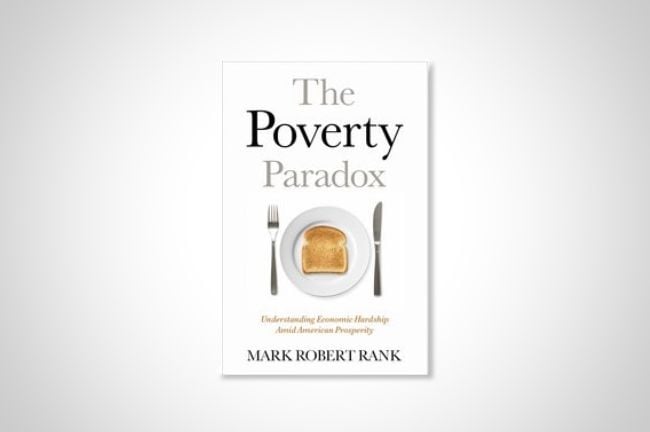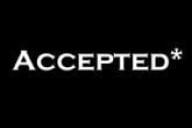You have /5 articles left.
Sign up for a free account or log in.

Oxford University Press
The Poverty Paradox: Understanding Economic Hardship Amid American Prosperity by Mark Robert Rank
Published in April 2023
The paradox of poverty in the U.S. is persistently high levels of individual economic hardship amid ever-increasing levels of societal wealth. In The Poverty Paradox, Washington University sociologist Mark Rank tries to understand what is going on.
If you are a reader who:
- A. Believes that the reason that people are poor is most a result of their individual choices …
- B. Are willing to be persuaded that the poverty story is more complex and that there are perhaps structural reasons outside of individual decisions that explain poverty …
then you should definitely read The Poverty Paradox.
As I’m increasingly convinced that the only books (and social media, news, and everything) that resonate with any of us are information and analysis that aligns with what we already believe, I’m doubtful that The Poverty Paradox will change many minds.
If you already believe that the opportunity structure is the determining driver of economic success, and you want to equip yourself with an analytical framework and detailed policy recommendations found in The Poverty Paradox.
One possibility to evolve some ideas, if not to change anyone’s mind, is to indulge in some lateral thinking. What if we applied the structural vulnerability framework that Rank introduces in The Poverty Paradox to universities?
Here, the unit of analysis shifts from individuals to colleges—people to organizations.
In the U.S., about one in eight people live in households below the poverty line. I don’t know the actual number—and I’m not sure that anyone does—but a ballpark estimate that one in eight institutions of higher education is in a financially precarious position seems reasonable.
A 2020 analysis by the Hechinger Report of 2,662 schools found that 500 (19 percent) were financially vulnerable.
To explain persistently high poverty rates, Rank compares individual economic well-being to a game of musical chairs. Imagine eight people circling seven chairs. When the music stops, one person will be left standing.
Are at-risk colleges playing a similar game of musical chairs? Is it possible that whatever actions are taken at every tuition-dependent institution, a significant portion of colleges will still be at risk of downsizing, merger or closure?
In other words, are the struggles of many colleges more the result of the environment in which they operate (demographic cliff, diminished public funding, a hollowed-out middle class), or are their challenges related to suboptimal choices made by institutional leadership?
When explaining poverty, as Rank details in The Poverty Paradox, an individual might do everything right and still end up poor. A full-time worker may lose a job. A family member might get sick. The rent could be raised and no affordable housing could be available. There might be no childcare that is accessible. The jobs available might pay too little to raise a family out of poverty.
Some colleges may do everything right but find themselves as economically vulnerable as the lowest-income Americans. These colleges might focus their programs and curriculum on the needs of their students. They might do everything possible to create courses and degrees that are financially accessible, flexible and high quality. The faculty and staff at these institutions may be fully dedicated to supporting their students and willing to work long hours for little compensation in support of that mission.
And yet, that same college—the one that made all the right choices—may have to close majors, lay off faculty and staff, and, in extreme cases, cease operations.
Where Rank is persuasive in The Poverty Paradox is that poor people are among the most scrappy and resilient of all populations. They must be, as navigating punitive public assistance programs and maintaining low-paying jobs is psychologically and physically demanding.
The people working at struggling colleges are every bit as smart, experienced, driven, creative, entrepreneurial and dedicated as those working at privileged institutions. Large numbers of colleges are struggling not due to their leadership, faculty and staff choices but to the economic, demographic and political structures they must navigate.
By not investing adequate public dollars in our students or institutions, we are making a choice about how the future of higher education will look. The great strength of our postsecondary system, the diversity of colleges and universities, and their ties to the communities in which they are embedded will be diminished due to our choices.
Taking a structural vulnerability approach to understanding precarious colleges does not mean that schools are powerless. Every tuition-dependent institution must figure out how to navigate an environment of demographic headwinds, state-level disinvestment and increasing costs and competition.
What applying ideas in The Poverty Paradox to higher education allows us to do is look first to broader forces and constraints that universities face in making sense of why so many institutions are struggling. We might think that in the absence of increased public investment, whatever bold, creative and entrepreneurial actions individual universities pursue, many will still find themselves financially vulnerable.
Some schools may try to protect themselves from economic shortfalls by laying off faculty and staff and closing majors, degrees and departments. These actions may seem necessary to university leaders, but they only impoverish the higher education ecosystem.
Absent the political will to invest in students and institutions, our system will become more unequal and less resilient. Students will have fewer options. The communities that depend on their local colleges as employers and creators of tomorrow’s workers and citizens will struggle.
The paradox of American higher education is the parallel stories of astounding wealth for a few institutions and ever-increasing financial precarity for a growing number of schools.
Might applying a structural vulnerability framework to universities persuade anyone to advocate for public investments in students and nonprofit schools?
What sort of lateral thinking helps you make sense of the current state and future of higher education?
What are you reading?








